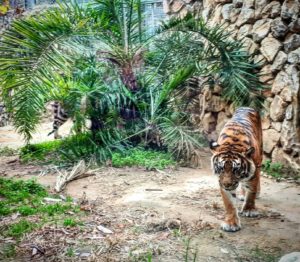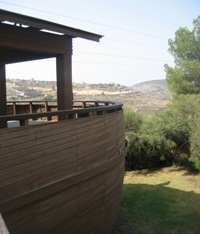Parashat Noah can be divided into two parts. The first tells us the story of Noah, his family and the flood myth. The second gives us an account of the history of mankind including the story of the tower of Babel. This Parasha is known and loved by most of the western world. Knowing this, it shouldn’t be such a surprise that Jerusalem has many sites that retell the tale or at least part of it. Thinking about the Parasha of Noah, I considered writing about Danziger’s Nimrod statue in the Israel museum or about The Bible Lands Museum. After rethinking the issue I decided to write about a place that refers directly to the story of Noah’s Ark – Jerusalem Biblical Zoo. It is a special place. Aaron Shulov, the founder of the zoo thought it necessary to establish a zoo that will serve as an academic research center and a visitor’s center. The story tells us that one day Shulov returned home and told his wife: “Yocheved, I decided to found a zoo in Jerusalem. I want the children of the city to be able to tell a dog and a jackal apart…” Shulov wanted the zoo to be influenced by its location in Jerusalem and to show a deep connection to the land of the bible. The Jerusalem biblical zoo was established in 1940 and changed it’s location a few times before settling in south west Jerusalem, its permanent home since the 1990’s. Elders of Jerusalem may remember the tiny old zoo that stood north of Tel Arza for years. These days it is one of the most popular sites in Israel.
The Jerusalem biblical zoo hosts many biblical animals, but also enables a meeting with the red panda, the Tapir and the Cacatua – animals that were never mentioned in the bible. What then makes this zoo a biblical zoo? There are many answers to the question and some deal with alternative animal names that are mentioned in the bible ( The “zemer” mentioned in the book of Deuteronomy chapter 14 is considered a Giraffe for instance) My personal answer to this question is situated in the furthest point from the gate – An ark-like visitor’s canter. The place is all about a single verse:
“You are also to bring into the ark two of every living thing of all flesh, male and female, to keep them alive with you. Two of everything – from the birds according to their kinds, from the livestock according to their kinds and from every animal that crawls on the ground according to its kind – will come to you so you can keep them alive.” (Genesis 6:19-20)It is a popular modern metaphor for Noah’s ark – the preservation of fauna of its era. Many animals will have been lost without Noah’s doing. The above citation emphasizes it well enough. The purpose of the ark was “to keep them alive” and the huge ark in the Jerusalem biblical zoo demonstrates its role in reviving and preserving wildlife in modern Israel. In a world experiencing a large scale extinction processes there is a significant importance for a struggle for preservation of the world’s wildlife. The zoo takes part in various re-introduction projects (the re-introduction of Fallow deer to the Nachal Soreq nature park for example), and tries to rear animals of Israeli endangered species. All those projects are presented to visitors in the heart of the Zoo’s wooden ark and demonstrate easily this highly important function of the Biblical Jerusalem institute.
While watching the ark situated in the heart of the Judea Mountains I recalled that the ark is also a symbol of longing for peace and quiet, a symbol of yearning for the end of a storm and the creation of a brand new world. This image is well described in and old poem by Ester Raab (as was translated by me).
I see A white Noah’s Ark Resting over the Judea Mountains: And an eye still gazes Upon corpses of many Icaruses. Their body: Both Seraph-angel And a Satan Beat their wings Into swords – And the eye gazes, awaiting The furrower And the vinedresserThe image of an ark on the Judea mountains and the semi-surrealistic sight of and ark in the middle of a zoo remind me that Yehuda Amichai once wrote that “Jerusalem is a port city on the shore of eternity…” (Yehuda Amichai, Poems of Jerusalem, p. 78). If the poet is right than the current location of the ark is wonderful, Second only to the Ararat Mountains. No doubt, the Jerusalem biblical zoo is the place to visit this week as we read the Parasha of Noah.


